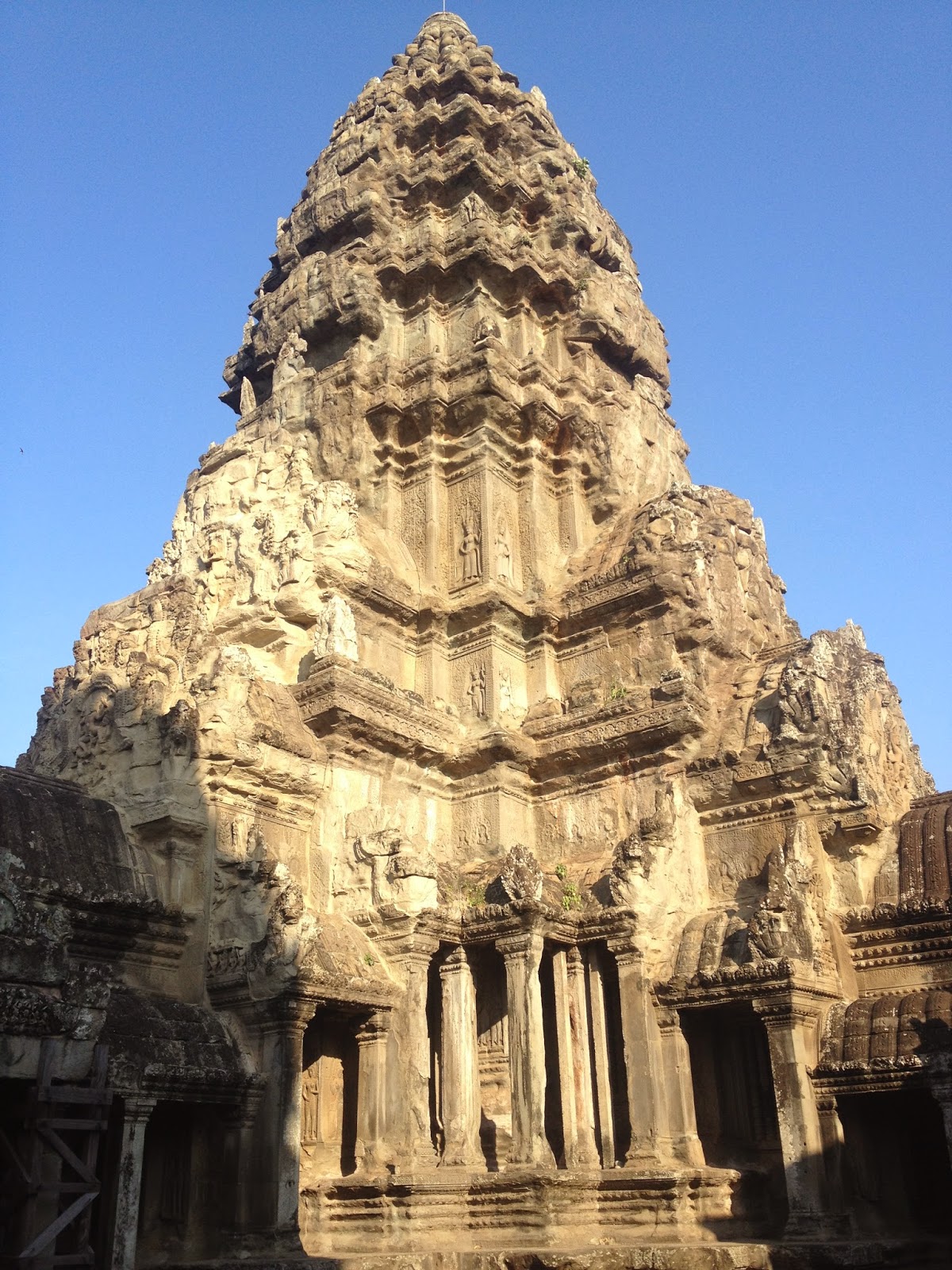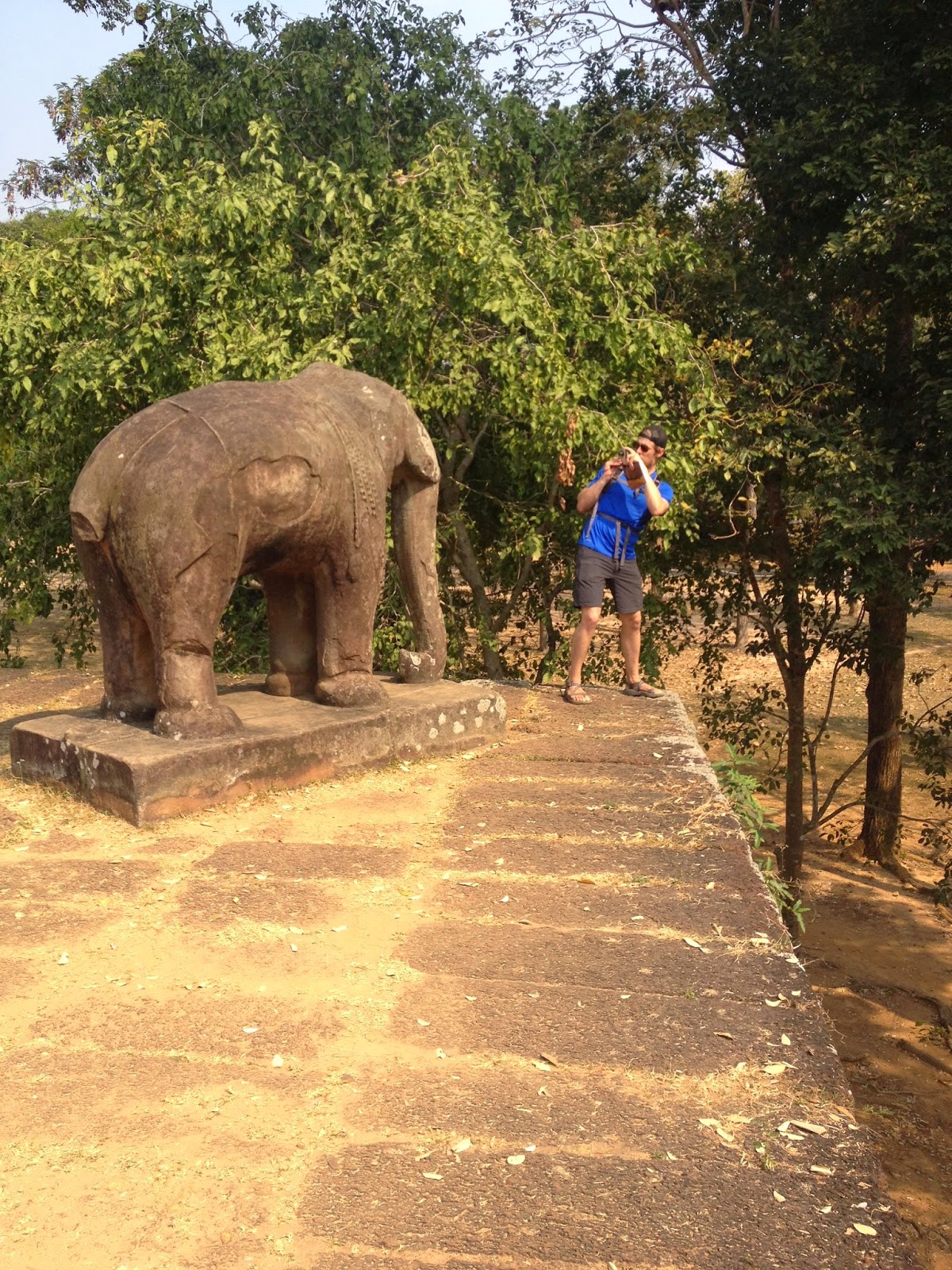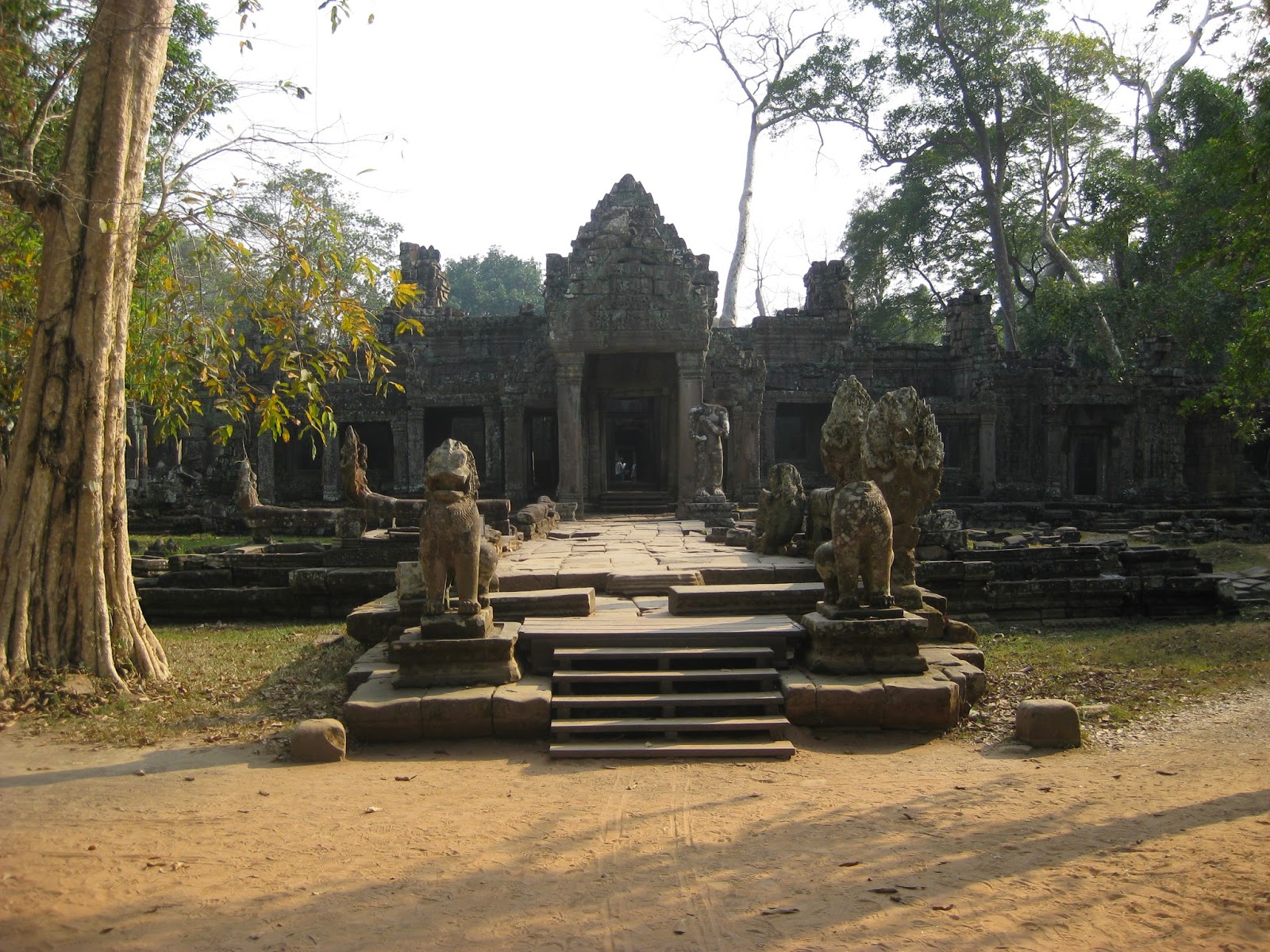But, first things first: we still haven't posted on the last two-thirds of our January vacation. From Ho Chi Minh City (Saigon), Vietnam, we took a bus into Cambodia. Though the border crossing was frustrating for the amount of time that it took -- primarily on the Vietnamese side -- there were no unexpected complications and we made it across in good order. Rachel snagged a couple of pictures (of dubious legality) as we crossed the border:
About 8 hours after leaving HCMC, we arrived in Phnom Penh, the capital and largest city of Cambodia. This was taken on our way into the city:
We were transported from the bus station to our hotel, as at many other points during our stay, by tuk-tuk. A tuk-tuk is a vehicle comprised of a passenger cart attached to a motorbike. Tuk-tuks are ubiquitous in Cambodia, and are basically the only option for a private taxi. Because they are so numerous, and the fact of our being tourists so obvious, we were constantly declining offers of tuk-tuks throughout our time in Cambodia (and Thailand, as well). It is hardly an exaggeration to say that we heard the question "tuk-tuk?" close to one hundred times per day.
Here are views of and from tuk-tuks:
In addition to the open-air aspect, another major difference from any previous experience we'd had with taxis is that there is no meter. Rather, the price for the fare must be negotiated prior to the journey. Unsurprisingly, tuk-tuk drivers tend to begin negotiations on the higher side, usually with the accompanying phrase "very far!". Rachel became quite adept at the process of haggling for fares, often coming equipped with a city map so as to show "we went further for less money previously", which normally led to fairer treatment. For this, and countless other reasons, she's an excellent travel teammate -- I'd highly recommend booking her for your next adventure.
Phnom Penh is the commercial, cultural, and government center of Cambodia, so there is a lot to see. Coming directly from the much larger (and often overwhelming) city of Saigon, we enjoyed it's smaller size and more relaxed pace -- but of course those distinctions are relative. The streets and markets of Phnom Penh are crowded and vibrant in ways that affect all five senses.
The following are from in and around the historic Russian Market:
Although the food in Phnom Penh, and Cambodia more generally, was not quite as exciting to us as that of Vietnam, we still enjoyed many good meals. Here's a typical dinner:
We savored an excellent lunch at Friends the Restaurant, a socially entrepreneurial training locale that seeks to improve the future prospects of street children and other marginalized young people by training them in all aspects of the food service industry. Anyone visiting Phnom Penh should make it a point to eat there at least once; I wish we'd had time to return. Some of the delicious items we had were beetroot/carrot/orange juice, a mango and passion fruit smoothie, crispy zucchini and cheddar fritters, honey garlic pork and beef meatballs, and a mango salad over grilled white fish:
Like most of Cambodia, or at least the parts we saw, Phnom Penh is tremendously flat. On the only hill in town sits Wat Phnom -- far from the only Buddhist temple, though certainly one of the most impressive:
The sign in the previous picture raises an interesting point: in addition to their own currency, the Riel (KHR), Cambodia also utilizes US Dollars. And not only are dollars accepted in unofficial, grey market situations, but can be withdrawn from ATM's, charged to credit cards at hotels, and so forth. Either the KHR or USD was accepted in any situation, and change for transactions paid in Dollars was always given in Riels, as American coins do not feature into their monetary system.
A few other notable sites in Phnom Penh include the Royal Palace and Independence Monument (these do not represent opposing notions; the "independence" in question was from French colonialists):
Some young monks-in-training in front of the palace:
Rachel made a new friend:
Monks need to make phone calls, too:
Cambodia-Vietnam Friendship Monument:
Independence Monument, which I thought was quite lovely:
There were many other beautiful landmarks in Phnom Penh, as well; these are merely some of the highlights that we saw. Of course, Cambodia has witnessed great tragedy, as well, with much of it centered around Phnom Penh. During the Vietnam War, American military aggression spilled over into Cambodia, then a nascent democracy struggling to find its way in the wake of colonialism. From 1969-1973, US forces dropped over 2.7 million tons of bombs on Cambodia, more than were dropped on Japan during the entirety of World War II -- including the two atomic bombs. Ostensibly, these bombing raids were carried out to disrupt North Vietnamese supply lines. More than 500,000 people were killed as a direct result of the bombing, and 30 percent of the Cambodia's population was internally displaced.
The country was greatly destabilized by this violence. Into this void stepped the Khmer Rouge, a group of Marxist guerillas led by a former schoolteacher named Pol Pot. The Khmer Rouge -- officially the Communist Party of Kampuchea -- seized control of Cambodia in early 1975, and remained in power until September of 1979, when a Vietnamese invasion forced them out. During the three years and eight months that they controlled Cambodia, the Khmer Rouge carried out a brutal genocide, killing between one and three million of their own people -- out of a population of just over eight million. Seeking to establish a new, self-sufficient nation built on agrarian communism, Khmer Rouge forced Cambodians out of the cities into slave labor in the countryside, Hundreds of thousands were executed or tortured to death, while untold thousands more died of starvation, disease, or exhaustion.
Fueled by paranoia, the Khmer Rouge killed anyone deemed remotely intellectual by the regime. As time wore on the Khmer Rouge began to target its own members, torturing and executing tens of thousands for suspicion of subverting the revolution. In order to carry out these horrors on such a large scale, the regime set up prisons and execution sites throughout Cambodia. One of the most infamous prisons, Tuol Sleng, was a former high school in Phnom Penh. We toured the Tuol Sleng Genocide Museum, which presents these atrocities, and much more of the Khmer Rouge's brutal history, with tremendous honesty in the exact location were so many occurred.
If they survived their torture, prisoners were taken about ten miles outside of the city to a former orchard called Choeung Ek, which came to be known as The Killing Fields. Mass graves containing nearly ten thousand bodies were discovered there following the demise of the Khmer Rouge. Sadly, Choeung Ek was just one of many sites of mass murder in Cambodia. While we do not have any pictures of the graves themselves, this beautiful monument, a Buddhist stupa, now stands to commemorate those that perished there.
So the Cambodian people have been through a great deal and, though things are better now, much of this brutality remains unresolved. The current Prime Minister of Cambodia, Hun Sen, is a former Khmer Rouge member. Trials and convictions of those who orchestrated the genocide have been difficult to come by; Pol Pot died under house arrest in 1998, having never been brought before a court.
After three nights in Phnom Penh, we boarded a bus and traveled about six hours northwest, to the city of Siem Reap. While we stayed in Siem Reap, our ultimate destination was not the city itself, but Angkor, the region just north of Siem Reap that served as the capital of the Khmer Empire, which ruled over much of mainland Southeast Asia from the 9th to 15th centuries. Covering over 1,000 square km (390 square miles), hundreds of sites from this civilization remain. The largest, most significant, and most spectacular structures remaining are the many temples that were built in the center of the region. Successive generations of rulers strove to build bigger, more ornate temples than their forebears, culminating in the construction of Angkor Wat, the largest religious monument in the world. It's simply impossible to fully grasp the size and scope of it from pictures alone, but we'll try our best.
We spent two full days exploring the temples by bike and foot -- two long, exhausting, sweltering, educational days that I doubt either of us will ever forget. We began our first day by watching the sun rise at Angkor Wat. The temple complex is surrounded by a huge moat, 200m (650 ft.) wide and forming a perimeter of over 5km (3 miles).
A family of monkeys enjoyed the morning scenery, as well:
These long hallways along the exterior are filled with intricate bas-reliefs, as shown below. There are over 600m of them at Angkor Wat:
Some monkeys getting feisty:
Baksei Chamkrong, an older temple (944-968). This was probably the most harrowing climb of any of the temples:
View from the top, looking down:
Angkor Thom was a huge city located just north of Angkor Wat. It contains numerous temples, but at the center is the largest and "newest" of any Angkorian temple, Bayon. Bayon was built in the late 12th or early 13th century, after Buddhism had spread throughout the region. Earlier temples, including Angkor Wat, were originally built as Hindu temples, then appropriated as Buddhist when that faith arrived. So, in many of the older temples one finds evidence of both religious traditions.
These guys were along all four main entrances to Angkor Thom. They are impressively well-preserved:
Rachel looking cute on her bike:
Not a Buddha face:
This guy seemed important. He was being followed around by a camera crew, and we'd seen him at the Killing Fields, as well. We had no idea who he was, but one of our coworkers later helped us identify him as celebrity chef Michael Voltaggio:
So, how about that.
We ended our first day as we began, back at Angkor Wat:
At some point, the temples begin to run together -- and it probably happens even faster for our readers than it did for us in the heat of Cambodia. Here are some other, various pictures from our second day of exploring Angkor:
You'll notice that Rachel has on a long skirt and her shoulders covered in all of the pictures, despite the intense heat. Since many of these temples are still in active use, modest dress is encouraged.
Ta Prohm is notable for the many trees intertwined with the ruins:
This temple, Neak Pean, was interesting for the man-made moat that it sits in:
It was a bit of a trek out this boardwalk to get to it:
There are hundreds of local vendors scattered around the temples. Here, a woman carves a pineapple for us to eat as a snack:
We ended the second day by watching the sun set at Angkor Wat. It's remarkable that such a structure exists in the world, and that it has for so long.
Relaxing, finally:
Our feet took quite a beating:
There were also some pretty sites to be seen in Siem Reap, itself. This is Preah Prohm Rath pagoda, which has quite an interesting history in its own right.
Here are some other scenes from around Siem Reap:
Me trying to play Jianzi, a local sporting activity. Think hacky sack but with a springy shuttlecock:
After a day of temple hiking, foot massages were warranted:
After six days in Cambodia, we left for Thailand. We'll save that for another post. I don't think either of us ever expected that we'd make it to Cambodia at any point in our lives, and we feel very fortunate to have had the chance. Despite the poverty of so many, Cambodia always felt safe and welcoming to us. Their economy is highly dependent on tourism, so we were always treated quite well, even if the constant sales pitches were a bit tiresome. We'd highly recommend going there, if you ever have the interest and opportunity.















.JPG)
.JPG)
.JPG)




.JPG)
.JPG)



.JPG)

.JPG)

.JPG)

.JPG)
.JPG)




.JPG)
.JPG)
.JPG)
.JPG)
.JPG)

























































































Your pictures are SO wonderful! I know you'll love printing some of those some day. Thanks for the history and information too - something I ashamedly don't know much about. You really got to see a lot!
ReplyDeletexxoo